Excerpts from Jim Conrad's
Naturalist Newsletter
from the July 22, 2012 Newsletter issued from the woods of the Loess Hill Region a few miles south of Natchez, Mississippi; elevation ~200ft (~60m), ~N31.42°, ~W91.41°; USA
SWEETGUM BALLS
Nowadays sometimes you find Sweetgum "balls" falling -- spherical, spiky fruit-heads. You can see an immature ball still on its twig below:
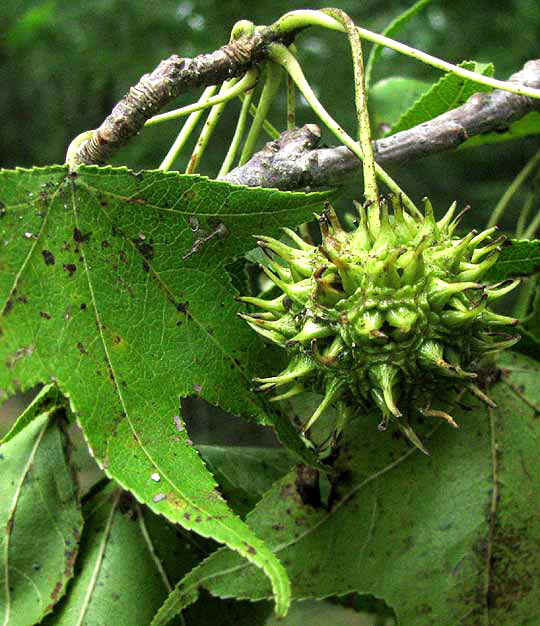
Sweetgum balls are technically known as capsular heads. Used in this sense, a capsule is a dry fruit composed of more than one chamber and which splits open at maturity to release seeds. In the picture, notice that the ball's spikes appear in pairs, and that the paired spikes often curve toward one another. Between some of them there are openings. What's happening is that each capsular fruit bears two spines, which in the flower were paired stigmas. Now the capsular fruit is opening between the two spines. You can see a mature ball with its capsules wide open and the papery-winged seeds already dispersed below:
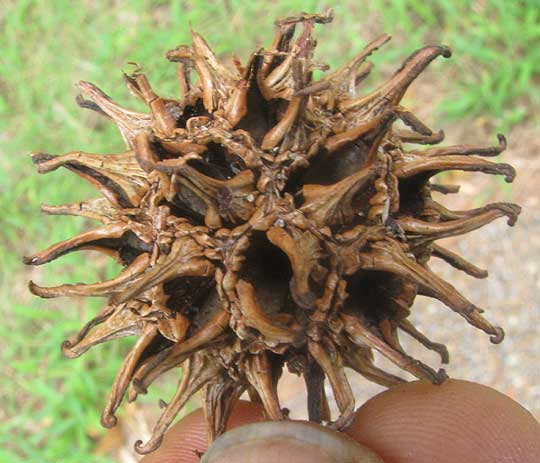
Notes from my hermit days in this area indicate that most Sweetgum balls fell in the winter. Really only a few balls are falling now, so I think I'm seeing the species merely being flexible and spreading its investments. In fact, I think of Sweetgums as a very adaptive species. On our Sweetgum page we document mountaintop island populations of Sweetgum in southern Mexico where the species is evolving toward predominantly three-lobed leaves instead of the mainly five-lobed leaves prevalent up here. Also, if you abandon a field in this area Sweetgums often are the earliest tree pioneers. Sweetgum's adaptability should serve it well as the effects of global warming intensify.
from the January 26, 2003 Newsletter issued from the woods of the Loess Hill Region a few miles south of Natchez, Mississippi; elevation ~200ft (~60m), ~N31.42°, ~W91.41°; USA
SWEETGUM BALLS FALLING
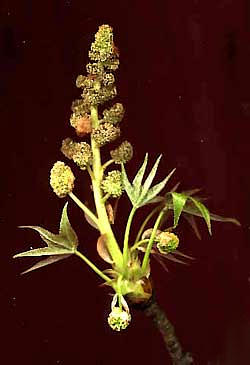 The most common forest tree here is the Water Oak, but where old fields are reverting to forest, as around my trailer, and along roadsides, Sweetgum is more abundant. Nowadays the ground beneath Sweetgum trees is littered with Sweetgum balls knocked down by the coldfront's winds. Sweetgum balls are often referred to as fruits of the tree, but really they are clusters of fruits. On Sweetgum trees, clusters of male and female flowers occur in different places on the same branch as the year's new growth expands in spring. You can see this arrangement at the right. I took that picture in the spring.
The most common forest tree here is the Water Oak, but where old fields are reverting to forest, as around my trailer, and along roadsides, Sweetgum is more abundant. Nowadays the ground beneath Sweetgum trees is littered with Sweetgum balls knocked down by the coldfront's winds. Sweetgum balls are often referred to as fruits of the tree, but really they are clusters of fruits. On Sweetgum trees, clusters of male and female flowers occur in different places on the same branch as the year's new growth expands in spring. You can see this arrangement at the right. I took that picture in the spring.
In the picture, the spherical items comprising an upward spreading pyramid are clusters of male flowers, while the three drooping spherical items are clusters of female flowers. After pollination, the male flower clusters fall off and litter the ground, but the female ones expand during the entire summer, gradually turning into spiny balls. At first the balls are green but later they turn brown.
The actual Sweetgum fruit is a slender capsule with a long, pointed neck. Many such capsules are joined at their bases so that their pointed necks are directed outward in every direction, and this makes the spiny ball. In the Sweetgum-ball picture you can see that each capsule has opened up so that it's sort of like a bird's open beak. It has opened to release its seed, which is a small, papery thing a little like a pine seed. The Sweetgum balls falling now also are opened up, looking exactly as in that picture, and they are murder to step on if you're a tired jogger on a paved road!
from the February 17, 2013 Newsletter issued from the valley of the Dry Frio River in northern Uvalde County, southwestern Texas, on the southern border of the Edwards Plateau; elevation ~1750m (~5750 ft); N29.62°, W99.86°; USA
SWEETGUM FLOWER BUDS EXPANDING
Though Sweetgums are among the most common trees in eastern North America they don't occur naturally this far west. However, there's a small one planted next to the cabin I stay in. It's stunted and half dead because the species isn't adapted for the long, rainless, very hot weather we experience most of the year. Still, now in February flower buds on at least some of its branches are expanding and about to open, and to me this is a welcome sign of spring. You can see some of the Sweetgum's fast-enlarging, twig-tip flower buds below:
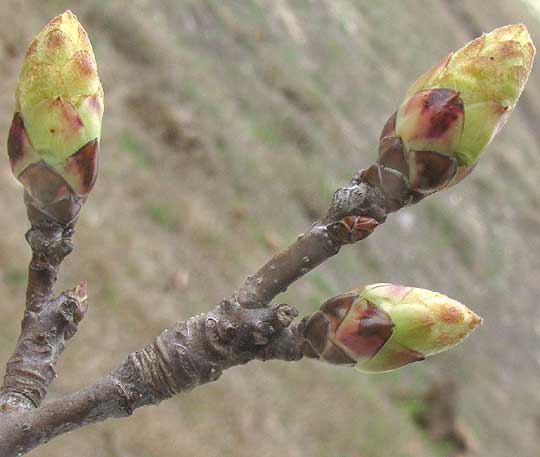
In that picture the smaller, brown scales at the buds' bases have enveloped the buds all winter when the buds were much smaller. Now those scales are spreading wide, permitting green, softer, interior scales to enlarge around the buds' expanding contents, the future flowers, stems and leaves. In that picture, notice that below the terminal flower buds there are much smaller buds containing embryonic leaves and stems that so far have expanded very little or none at all.
In the previous entry we saw what the contents of such buds will look like once the flowers and leaves have burst out. All the flower, leaf and stem material shown in the picture of the opened terminal bud already exists in our Sweetgum's expanding buds, as can be seen in a picture showing a bud before and after it was cut down the middle to expose its contents below:
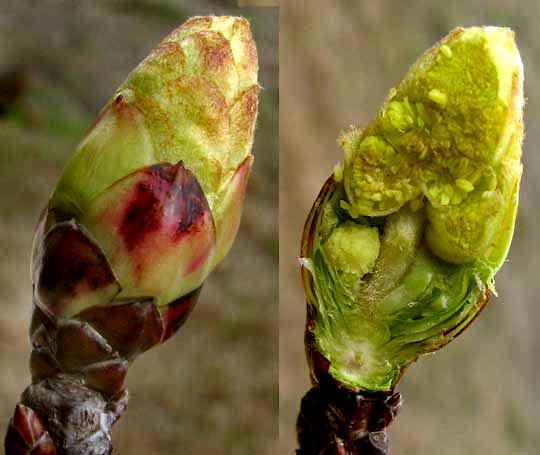
In the above image most of the bud is filled with the granular, yellow, pollen-producing anthers of the future male flowers, while at the base, at the left of the cluster of male flowers, there's at least one smaller, paler, immature ball of female flowers from which a future fruit may develop. Below the flower balls several thin layers of green vegetative material is visible. The inner layers are cut-across future leaves.
Speaking of leaves, with tweezers I removed the scales of a small leaf bud growing below a terminal bud. Inside the scales were green leaves with their five lobes directed upward, shown below:
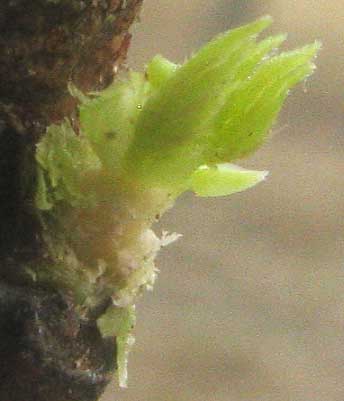
What a pleasure having the little Sweetgum tree next to the cabin harbingering so eloquently the coming of spring.
from the January 6, 2013 Newsletter issued from the valley of the Dry Frio River in northern Uvalde County, southwestern Texas, on the southern border of the Edwards Plateau; elevation ~1750m (~5750 ft); N29.62°, W99.86°; USA
SWEETGUM TWIGS
Sweetgum trees are one of the most commonly occurring trees in most of the eastern US. Around my old hermit camp in Mississippi they were the most numerous woody species. Here we're well west of their natural distribution in the US, but there's a planted one next to the cabin. It almost died during our droughty last two summers, but somehow it's still holding on.
I find myself drawn to that tree, less from sentimentality than from the fact that our low, scrubby forest here is so dominated by two tree species -- Ashe Junipers and Texas Liveoaks -- that it's just a pleasure to see a different tree.
The tree has lost all of its star-shaped leaves, which just before they fell were prettily crimson and yellow. What's left is reddish-yellow twigs with buds pleasing to look at. I suppose it's the promise of spring in each of those buds that attracts me, knowing that just inside the buds' armor of shiny scales there's green, very fragile, embryonic material from which later will arise spring's new leaves and twigs. You can one of our Sweetgum's twig tips below:
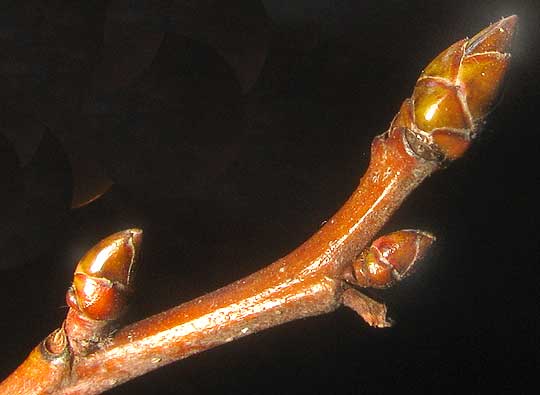
Really it's beautiful how bud scales protect such easily harmed embryonic material through winter's extremes. Of course they protect from the cold, but also they keep the green matter inside from drying out. Also, sometimes even in winter, a whole day's sunshine can douse a twig with dangerous amounts of ultraviolet radiation and even heat, and bud scales need to protect against those, too.
In the above photo you might notice the leaf scar at the base of each bud. When a deciduous leaf naturally breaks from its twig in autumn, it leaves a leaf scar. Leaf scars come in many shapes and sizes. You can see the Sweetgum's leaf scar at the base of a bud below:
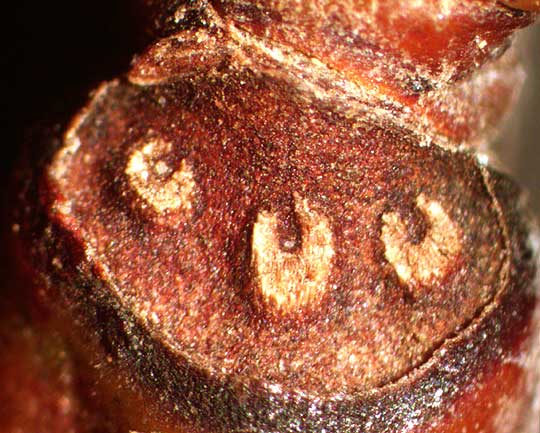
The three pale, horseshoe-shaped features inside this leaf scar are bundle scars. To understand what bundle scars are, remember that inside a woody stem there's a vascular system that carries water and nutrients from the roots up to the leaves (the xylem part of the system) and photosynthesized carbohydrates from the leaves down to the rest of the plant body (the phloem part). When the vascular system encounters a part of the stem from which a leaf arises, strands of xylem and phloem depart from the main vascular system and unit into bundles that enter the leaf stem, or petiole. In some species only one bundle enters a leaf through its petiole, in others there may be several bundles. You can see that Sweetgum leaves have three. When the leaf falls in autumn, it breaks across a well defined abscission zone, also called a separation zone, at the base of the petiole. When the petiole breaks off, it leaves a leaf scar, and inside the leaf scar there are bundle scars.
Not only do different woody species bear leaf scars of many different sizes and shapes, but also the numbers of bundle scars within the leaf scars is consistent within species, but highly variable between them. And the patterns made by the dispositions bundle scars vary, and the bundle scars' shapes.
Often but not always, Sweetgum stems also bear "wings," or corky ridges of a kind seen on few other species, as shown below:
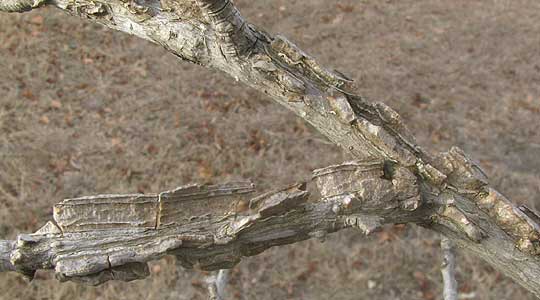
Maybe such wings make the stems stiffer and less vulnerable to breakage; maybe the wings help regulate temperature in the stem. Whatever the case, it's clear that the typical twig bears very many interesting field marks that help us identify and admire leafless, flowerless, fruitless, winter-stuck trees.
from the December 17, 2007 Newsletter issued from Yerba Buena Clinic near Pueblo Nuevo Solistahuacan, upland Chiapas, MÉXICO
SWEETGUMS IN MEXICO
Our Sweetgums are starting to turn a bit yellow, about like they would back in Kentucky in September. You can this below:

When I see yellowing Sweetgum leaves glowing beneath such a splendidly blue sky I'm filled with a sense of nostalgia. Somehow sun-glowing Sweetgums represent a certain feeling that's been important during much of my life, the feeling of long September woods-walks in Kentucky, of sitting around my hermit campfire in late fall in Mississippi, etc.
Of course, it's not quite the same. For one thing, notice that a good number of the leaves in the picture are three-pointed.
You've seen that in our relict "sky islands" some plants are considered the exact same species found in eastern North America, some are different subspecies of the same species, and others are "sister species," which means that our species and the North American ones are regarded as having arisen from common ancestors. This dynamic reflects the fact that some organism groups evolve faster than others. Apparently Sweetgums evolve slowly while those of our species represented by sister species in the North evolve fast, and those being the same species as in the North but different subspecies evolve at an average rate.
Chiapas's Sweetgums are regarded as the very same species as occurs up North, Liquidambar styraciflua. However, I've often noticed that, on the average, northern plants tend to produce more five-pointed leaves while our Chiapan plants have more three-pointed leaves. Our Chiapan plants seem to be evolving toward a new three-pointed subspecies, but experts don't regard them as having evolved that far yet.
from the March 8, 2005 Newsletter issued from "Cyber El Profe" in Pantepec, upland Chiapas, MÉXICO
SWEETGUM & PINE-NEEDLE BATHS
A firewood cutter dropped by our hut so I asked him which plants had special uses. The main trees around us were Sweetgums and pines, so he told me what his people did with Sweetgum leaves and pine needles: They put them in boiling water (one or the other, not mixed together) then when the water cooled to body temperature they bathed in it.
The young man smelled of woodsmoke and old sweat, for he had worked a long day cutting and carrying firewood. However, I knew that when he went to town he'd be cleaner than I usually am. And, just think: Sometimes when he goes, he smells freshly of Sweetgum or pine.
from the July 13, 2003 Newsletter issued from the woods of the Loess Hill Region a few miles east of Natchez, Mississippi, USA
SWEETGUM LIQUID-AMBER
When forest is cut, Mother Nature instantly starts healing the wound. One thing she does is to send in seeds of plants that will stabilize the soil and add nutrients and organic matter. These seeds are usually light, small ones that wind can carry into the wound area. Around here, the trees providing this kind of seed are mainly Loblolly Pine and Sweetgum. In the big field next to the barn, Loblollies mostly provide the seeds, but right around the barn itself it's Sweetgum.
When I arrived here, in places near the barn, Sweetgums had grown up like cane -- dozens of thin, spindly saplings forming veritable walls. Because of the fire hazard I was asked to clean them out, and this I've done with the machete I used to cut tobacco when I was a farmboy in Kentucky. During recent mornings as I macheted the Sweetgums, the hot, profoundly humid air around me became suffused with odors of crushed herbage and sweet, oily balsam.
The balsam odor was associated with Sweetgum's "gum." If you damage a Sweetgum's trunk or stem, a resin is exuded that slowly thickens into an amber-colored gum, which eventually hardens into a pale yellow encrustation. The Sweetgum's Latin name is LIQUIDAMBAR STYRACIFLUA. In this case the genus name is beautifully descriptive, referring to the gummy "liquid amber."
Sweetgums belong to the Witch-hazel Family. Remembering Witch-hazel's medicinal value, and smelling the wonderful balsam odor of the gum, you might guess that Sweetgum also is medicinal. On the Internet I read that "The bark and leaves, boiled in milk or water, have been used to treat diarrhea and dysentery. The boiled leaves have been applied to cuts and used for treating sore feet. The aromatic drug resin storax, an expectorant and a weak antiseptic used for treating scabies, comes from this tree." Elsewhere I read that its gum has been used internally in the treatment of sore throats, coughs, asthma, cystitis, and dysentery, and externally for sores, wounds, piles and ringworm.
Some years ago I spent a winter writing a book based in the highlands of Chiapas, southern Mexico. High in the mountains just below the cloudforest zone, our Sweetgums mingled with Mexican oaks and pines. When the last Ice Age ended and things were warming up again, part of our Eastern North American forest, which had taken refuge there far in the South, followed the warm weather back northward. Another part of our exiled forest simply migrated up the mountain slopes, keeping within the weather regimen it liked. Today Sweetgum is only one of several such North American forest species finding refuge on isolated south-Mexico and Guatemalan mountaintops.
The Tzotzil-speaking Indians of that area have a high regard for Sweetgum. Often I've seen Indian children poking at Sweetgum trunks, nudging out gum to chew. In the markets you can buy granules and powder of dried Sweetgum gum for the preparation of incense. You make a small pile of wood shavings from a tree with aromatic wood such as the Cedro (Cedrela mexicana) mixed with granulations of dried Sweetgum gum, then set the pile to smoldering, not burning. The resulting white smoke makes an incense redolent of purity, mystery and deep history. In Oaxaca they call Sweetgum Ocozote. During the time of Montezuma and the Aztec civilization, southern Mexico supplied the great Mexican Aztec capital city of Tenochtitlan with Quetzal feathers and Sweetgum resin, and both of these commodities were regarded as rare and wonderful.
I always feel bad about cutting a tree, even when it's a "weed tree" living where it shouldn't. When I cut trees, I try to maintain a ceremonial frame of mind out of respect for the lost tree-lives and because of all the potentials I am spoiling. This week it has seemed that the Sweetgums did their part to maintain the proper ceremonial ambiance.